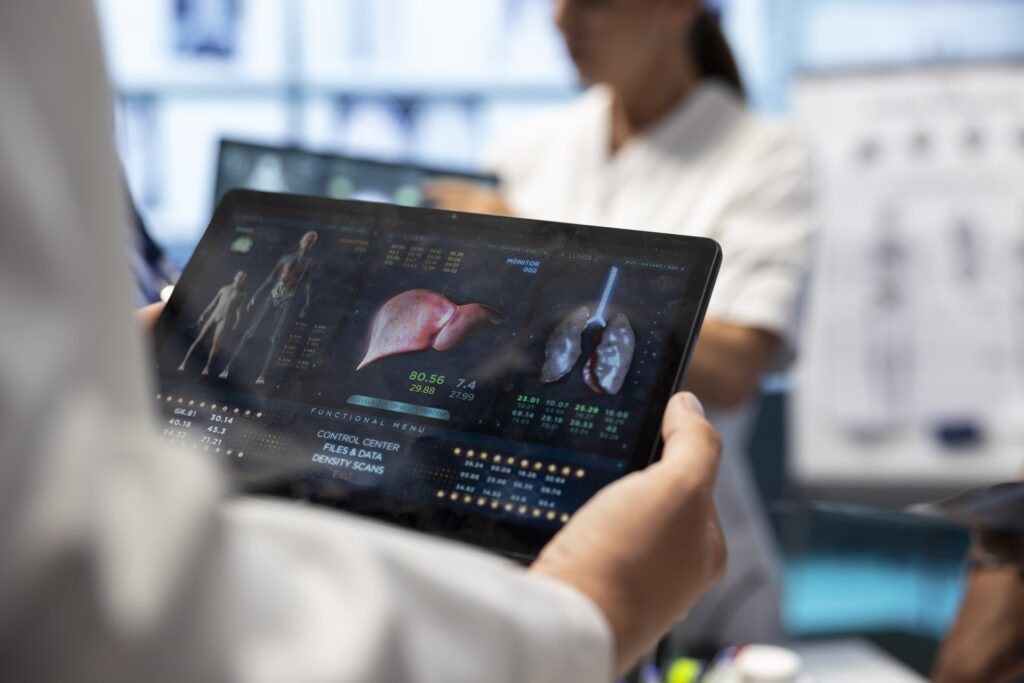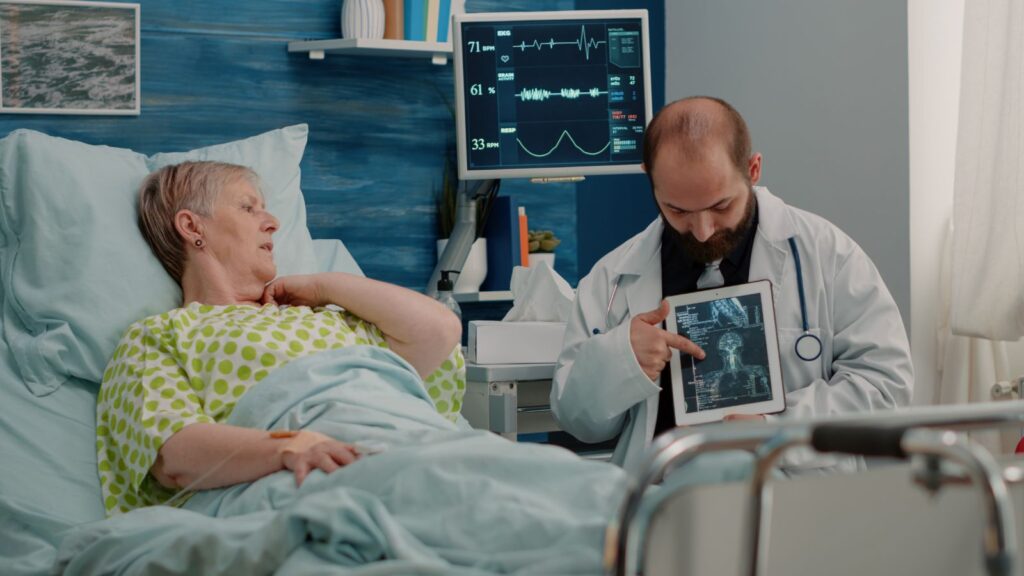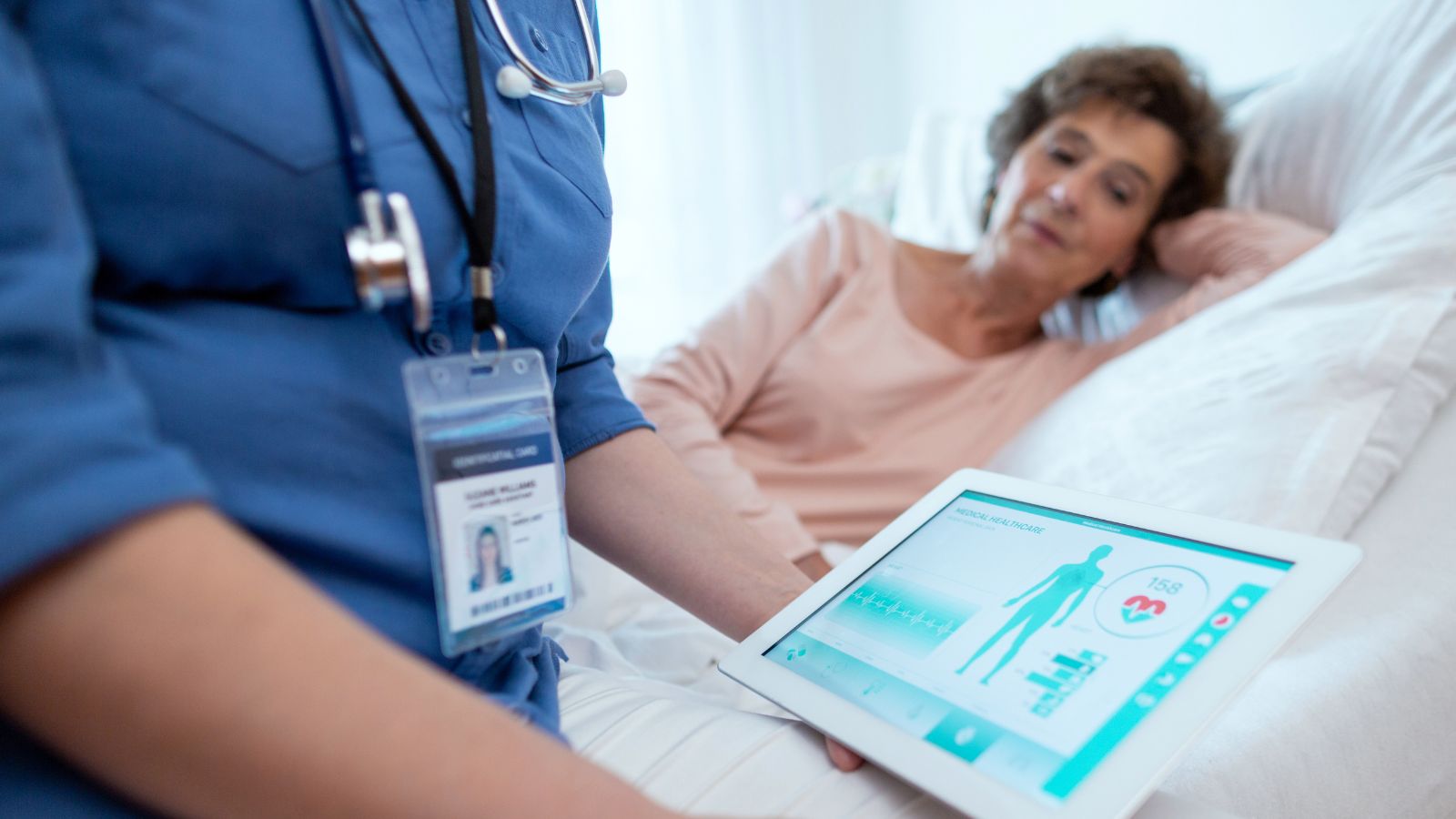Your healthcare practice is under constant pressure to enhance patient care while keeping costs low and efficiency high. The ability to instantly access complete health information data revolutionizes your approach to clinical decisions and patient treatment.
Today’s healthcare providers must have immediate insights into patient conditions to offer the best healthcare services available. With instant access to medical histories, test results, real-time insights, and treatment plans, you can better predict health outcomes and respond quickly to patient needs.
Electronic health record systems, such as Mediportal, are key to this revolutionary transformation in electronic medical records. They connect all patient health data in one accessible platform. This reduces clinical workflow burdens and significantly improves patient outcomes. The immediate availability of information directly affects your ability to deliver quality healthcare while managing operational costs.
Key Takeaways
- Immediate health information access improves clinical decision-making and improves patient care quality
- Healthcare providers can predict patient outcomes more accurately with complete data visibility
- Electronic health record systems reduce workflow burdens and operational costs
- Real-time data connectivity transforms healthcare delivery efficiency across organizations
- Instant patient information access directly correlates with improved health outcomes
- Modern healthcare practices require robust data management systems for optimal performance

Why Real-Time Access to Patient Data Is Essential for Modern Healthcare
Your healthcare practice needs instant patient information and immediate access to care to meet today’s care standards. The benefits of real-time data access extend far beyond simple convenience. They create a foundation for safer, more coordinated, and more effective care delivery.
Doctors, nurses, and physician assistants who use real-time data in health systems can make informed decisions quickly. This capability transforms how your medical team approaches patient care with real-time clinical data and ensures enhanced patient outcomes. It also reduces the risks that come with delayed or incomplete information.
| Healthcare Aspect | Traditional Data Access | Real-Time Data Access | Patient Impact |
|---|---|---|---|
| Drug Interaction Detection | Manual chart review, delayed alerts | Instant automated warnings | Prevents adverse reactions |
| Care Team Communication | Phone calls, paper notes | Integrated messaging systems | Faster treatment adjustments |
| Emergency Response | Searching multiple systems | Immediate access to full history | Life-saving quick decisions |
| Chronic Disease Management | Periodic check-ins only | Continuous monitoring alerts | Proactive intervention |
Enhanced Patient Safety and Reduced Medical Errors
Data analytics help manage drug therapy in real time to identify possible side effects and drug interactions. Your healthcare team can spot problems before they become serious complications. This immediate awareness significantly reduces medical errors.
Healthcare analytics systems flag dangerous combinations instantly. When you prescribe medications, the system checks against all current prescriptions. It also reviews patient allergies and previous adverse reactions.
Real-time monitoring helps identify patients with chronic conditions who need immediate attention. The system tracks vital signs and lab results continuously. These important data points are vital, especially when it send alerts when values fall outside safe ranges.
Mediportal’s integrated approach with data in real time, ensures your team never misses critical safety warnings. The platform consolidates all of the patient details in one accessible location. This view helps healthcare professionals enhance patient safety at every interaction.
Improved Patient Care Coordination and Communication
Having access to real-time data is transforming the healthcare industry. Care coordination through integrated systems communicates across departments seamlessly. Your nursing staff, physicians, and specialists all access the same updated information. This shared access eliminates confusion and duplicate testing.
Real-time healthcare data can help healthcare systems interface with other care facilities automatically. When patients transfer between locations, their complete medical history follows them. This continuity prevents treatment delays and medication errors.
Healthcare data flows between departments without manual intervention. This enables healthcare providers to access sensitive patient information seamlessly for better care for patients. Lab results appear instantly in physician dashboards. Nursing notes update immediately for all team members to review.
Modern healthcare requires this level of integration to function effectively. Your practice can coordinate care with hospitals, specialists, and other providers. The result is smoother transitions and better patient experiences.
Faster Emergency Response and Critical Decision-Making
Artificial intelligence and predictive analytics identify high-risk patients for certain complications. The real-time data allows these systems to analyze patterns in healthcare data to predict problems that could directly impact patient care. Your team receives early warnings and data directly about patients who need closer monitoring.
Emergency situations demand immediate access to complete patient histories. Real-time systems provide instant access to allergies, current medications, and previous procedures. This information helps your team make life-saving decisions quickly while allowing healthcare services remotely to be provided.
Healthcare professionals can extract meaningful data for effective decision-making processes instantly. The system presents relevant information based on the current situation. Critical details appear prominently, while less urgent data remains accessible but secondary.
Real-time analytics support clinical decision-making with evidence-based recommendations. The system suggests treatment options based on current guidelines and patient-specific factors. This guidance helps your team provide optimal care even in high-pressure situations.

How Real-Time Data Collection Improves Patient Outcomes and Patient Care Quality
Modern healthcare uses real-time data systems to change how it monitors and treats patients. This allows your practice to make quick, informed decisions, leading to better care. Real-time analytics give your team ongoing insights, turning reactive care into proactive strategies.
Having immediate access to patient data does more than just save time. It lets your healthcare practice spot health trends, prevent problems, and offer tailored interventions. This shift towards precision medicine means every decision is informed by the latest, most complete data.
Proactive Management of Chronic Conditions
Real-time data plays a pivotal role in the management of chronic illness. Your team can revolutionize managing chronic diseases with ongoing data monitoring and analytics. Patients with diabetes, hypertension, and heart disease get quick alerts on health trends. This leads to timely interventions before issues escalate.
A study with 242,848 Kaiser Permanente patients showed that early primary care telemedicine boosts HbA1c measurement rates and lowers levels. Your practice can achieve similar results with real-time monitoring systems for vital health indicators.
Research shows digital interactions help lower HbA1c and weight in diabetic patients. Your team can adjust treatment plans immediately, avoiding costly emergencies and hospital stays.
Personalized Care Plans and Enhanced Patient Experiences
Real-time patient data lets your practice tailor treatments for better satisfaction and outcomes. Your team can instantly customize care plans based on current health, preferences, and treatment responses.
Mediportal’s integration ensures your practice has all patient data at hand. This view helps your team coordinate care, avoiding duplicate tests or conflicting treatments.
Personalized care goes beyond medical treatments to include communication preferences and scheduling. Tailoring interactions to individual needs boosts engagement and treatment adherence.
Remote Patient Monitoring and Telehealth Capabilities
Your practice can extend care beyond office visits with advanced remote monitoring and telehealth. Real-time data lets your team oversee patients continuously, spotting issues early for timely interventions and to prevent any disparities in healthcare.
The Kaiser Permanente study shows cost savings and fewer urgent care visits with remote monitoring. Your practice can achieve similar efficiency gains, improving patient access to quality care. Remote monitoring also reduces facility burden while ensuring consistent patient attention.
Telehealth, backed by real-time analytics, lets your team conduct virtual consultations with full patient data access. This approach keeps care continuous and offers patients easy access to medical expertise.
| Care Delivery Method | Patient Outcomes | Cost Efficiency | Healthcare Team Benefits |
|---|---|---|---|
| Traditional In-Person Care | Limited monitoring between visits | Higher facility overhead costs | Reactive treatment approach |
| Real-Time Remote Monitoring | Continuous health tracking | Reduced urgent care visits | Proactive intervention capabilities |
| Integrated Telehealth | Improved HbA1c levels | Significant cost savings | Enhanced care coordination |
| Hybrid Care Model | Optimal patient satisfaction | Maximized resource utilization | Comprehensive patient insights |
Your practice benefits from real-time data systems for both in-person and remote care. This approach ensures data security and maximizes patient care across all modalities. The combination of proactive monitoring, personalized plans, and remote capabilities forms a strong foundation for superior healthcare.

Implementing Real-Time Data Access Through Advanced EMR Systems
Your healthcare practice can achieve seamless real-time data access through properly implemented EMR systems. The right technology foundation transforms how your clinical team delivers patient care. Modern EMR platforms must integrate advanced capabilities that support instant information sharing across your entire healthcare network.
Success depends on choosing systems that prioritize interoperability and user experience. Your implementation strategy should focus on solutions that eliminate data silos while maintaining clinical workflow efficiency. The healthcare industry faces significant challenges with fragmented systems that don’t communicate effectively.
Essential Features for Real-Time Healthcare Analytics and Data Management
Effective real-time data collection requires specific technical capabilities built into your EMR system. Your platform must aggregate data from diverse sources instantly without compromising accuracy. Cloud-based architecture ensures your team maintains access to real-time data across various healthcare settings.
Learn more about our EMR for Family Medicine
Integration APIs enable seamless connectivity between different healthcare applications. Your system should support automatic data synchronization that updates patient records immediately when new information becomes available. This capability helps healthcare professionals make informed decisions at the point of care.
Advanced analytics tools transform raw data into actionable insights for your clinical team. Data analytics in healthcare becomes more powerful when your system can process information in real-time. Your EMR should include dashboard features that highlight critical patient alerts and trending health indicators.
Mobile accessibility ensures your healthcare providers can access patient data from any location. Using real-time data becomes more effective when your team can review records during patient consultations or emergency situations. Cross-platform compatibility supports coordinated care delivery across your entire practice.
How Mediportal Delivers Seamless Real-Time Patient Information
Mediportal addresses the common integration challenges that plague healthcare practices today. Our EMR software provides immediate access to critical patient data through intuitive interfaces designed for clinical workflows. Your healthcare team can access complete patient histories, lab results, and treatment plans instantly.
The Mediportal architecture eliminates the communication barriers between different healthcare systems. Instead of managing multiple disconnected platforms, your practice benefits from unified data management. Our solution reduces administrative burden while improving clinical decision-making capabilities.
Real-time synchronization ensures your patient records remain current across all access points. When laboratory results arrive or vital signs are recorded, Mediportal updates the patient file immediately. This functionality supports better patient outcomes through timely clinical interventions.
Our platform includes advanced reporting tools that help healthcare teams identify trends and patterns in patient data. These analytics capabilities support proactive care management and help predict patient needs before complications arise. Mediportal transforms routine data entry into strategic healthcare planning.
Addressing Data Security and Integration Challenges in Various Healthcare Settings
Healthcare organizations face significant obstacles when implementing access to real-time data systems. Over a dozen different EHR systems operate without effective communication protocols. This fragmentation creates gaps in patient care and increases the risk of medical errors.
Data security requirements demand robust protection measures for patient details and information. Your EMR system must comply with HIPAA regulations while maintaining fast data access speeds. Encryption protocols and access controls protect sensitive healthcare data without slowing clinical workflows.
System integration challenges require careful planning and technical expertise. Each healthcare organization can choose systems tailored to specific needs, but interoperability remains essential. Your implementation strategy should prioritize solutions that communicate effectively with existing healthcare infrastructure.
Privacy compliance adds complexity to real-time data sharing initiatives. Healthcare solutions must balance immediate information access with strict regulatory requirements. Audit trails and user authentication systems ensure accountability while supporting clinical efficiency.
The future of real-time data in healthcare depends on overcoming these technical barriers. Successful implementations focus on reducing healthcare costs through improved operational efficiency. Your practice benefits when EMR systems eliminate redundant data entry and streamline communication processes.
| Integration Challenge | Impact on Care | Mediportal Solution |
|---|---|---|
| System Fragmentation | Delayed access to patient records | Unified data platform with API connectivity |
| Data Security Concerns | Restricted information sharing | HIPAA-compliant encryption with role-based access |
| EHR Burnout | Reduced clinical efficiency | Intuitive interface design with workflow optimization |
| Compliance Requirements | Complex implementation processes | Built-in compliance tools with automated reporting |
Conclusion
Real-time data is revolutionizing healthcare, impacting patient outcomes and your practice’s success. As the healthcare industry evolves, your organization must rely on real-time data to stay competitive. This ensures high-quality care delivery.
The quality of care hinges on accessing data in real-time. This capability lets healthcare providers tackle healthcare disparities while keeping patient information secure. Real-time data enables your team to offer seamless patient care, meeting the expectations of patients, payers, and healthcare professionals.
Real-time data empowers your practice to make informed decisions. It directly influences your daily operations, allowing for better patient care and cost optimization. Data is key in navigating the complex demands of healthcare stakeholders.
Mediportal’s EMR system equips your practice to harness these capabilities. Real-time data gives healthcare organizations the tools to thrive in today’s data-driven world. It helps your practice stay competitive while delivering exceptional patient experiences, defining modern healthcare excellence.
Your investment in real-time data capabilities sets your practice up for sustained growth and improved patient satisfaction in the evolving healthcare landscape.
FAQ
What is real-time data in healthcare, and why is it important?
Real-time data in healthcare refers to patient documentation available immediately and updated continuously. It includes vital signs, lab results, and medication records. This data is critical for healthcare professionals to make quick decisions, improving patient outcomes and care quality.
How does real-time access to patient data enhance patient safety?
Real-time access to patient data significantly enhances patient safety. It allows healthcare providers to identify drug interactions and allergies immediately. This prevents serious medical errors, ensuring safer care and better patient wellbeing.
What role does real-time data play in emergency care situations?
In emergency care, real-time data is vital. It provides immediate access to critical patient information, essential for life-saving decisions. Real-time analytics and AI help identify high-risk patients and complications, ensuring effective and safe treatments.
How can real-time data analytics in healthcare improve care coordination among healthcare providers?
Real-time data improves care coordination by enabling seamless communication. Integrated systems share patient information instantly, reducing delays and miscommunications. This ensures consistent and effective care delivery across departments and facilities.
What are the benefits of real-time data for managing chronic conditions?
Real-time data enables proactive management of chronic conditions. It allows continuous monitoring and early identification of trends. This leads to immediate adjustments in treatment plans, improving health outcomes and preventing hospitalizations.
How does real-time patient monitoring support remote patient care?
Real-time patient monitoring supports remote care through telehealth. Patients can be monitored continuously at home, with data transmitted to healthcare teams. This approach reduces urgent care visits and maintains high-quality care while saving costs.
What essential features should healthcare organizations look for in the future of real-time data management systems?
Essential features include seamless integration, intuitive interfaces, and robust analytics. Systems should also aggregate data from diverse sources, ensuring immediate access to critical patient information across various settings.
How does real-time data analytics help healthcare professionals make better decisions?
Real-time data analytics provide immediate insights into patient conditions. They enable predictive analysis and support evidence-based decision-making. These analytics help deliver personalized treatments, reducing healthcare costs.
What are the main challenges in implementing real-time data systems in healthcare?
Challenges include ensuring data security and privacy, integrating different electronic health record systems, and managing data complexity. Training healthcare staff to use new systems efficiently is also a challenge.
How can real-time data help reduce healthcare costs?
Real-time data prevents medical errors and adverse events, reducing costs. It enables early intervention for chronic conditions, optimizes resource utilization, and supports remote monitoring. These efforts decrease the need for frequent in-person visits.
What impact does real-time data have on patient satisfaction and experiences?
Real-time data enhances patient experiences by enabling personalized care plans. It reduces wait times, improves communication, and provides immediate access to health information. This leads to higher patient satisfaction and better engagement in healthcare management.
How does real-time data integration improve healthcare delivery efficiency?
Real-time data integration eliminates duplicate data entry and reduces administrative burden. It enables faster decision-making, streamlines care coordination, and optimizes workflow. These efforts reduce clinician time burdens while maintaining quality standards.

